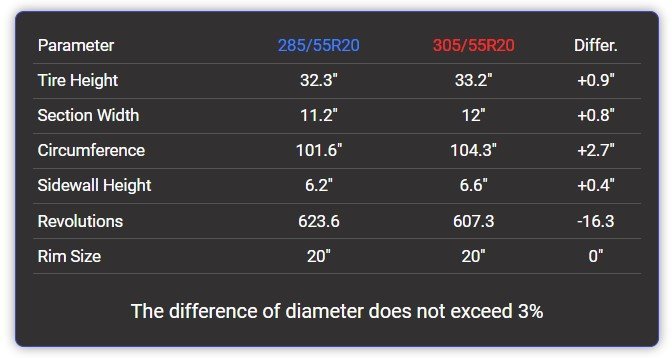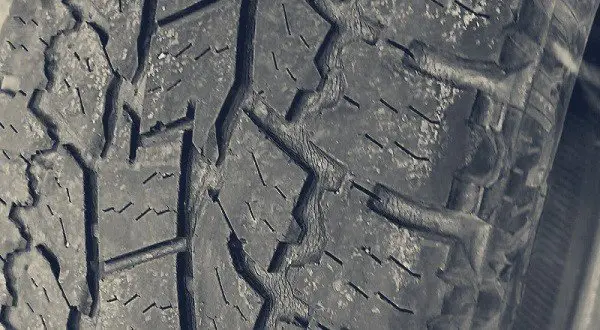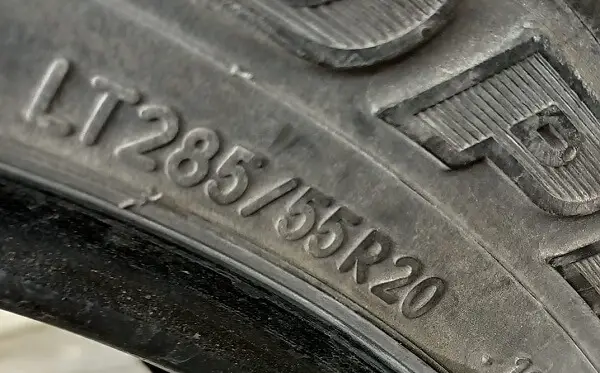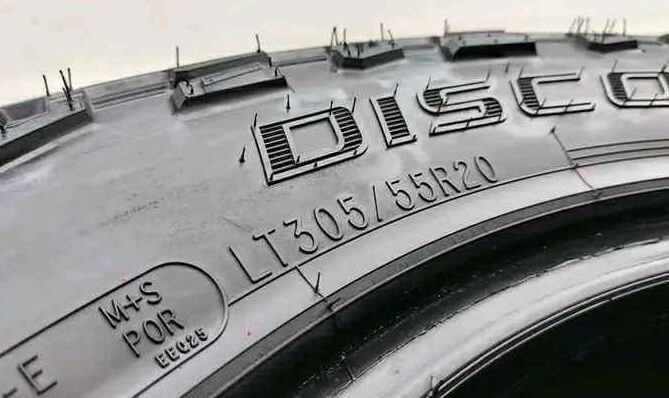Tire Size 285/55r20 vs 305/55r20

Upgrading your tires from 285/55r20 to 305/55r20 is a popular choice for drivers seeking improved performance and aesthetics. This switch increases tire width by 20mm and overall diameter by 22mm, offering a balance of enhanced capabilities and minimal vehicle adjustments.
- Wider tires provide better traction especially in off-road conditions
- Increased diameter offers slightly improved ground clearance
- Larger tires may slightly reduce fuel efficiency
- Speedometer accuracy is affected by about 2.7%
- Aesthetics are enhanced with a more aggressive look
285/55r20 vs 305/55r20 Table
The primary difference between 285/55r20 and 305/55r20 tires lies in their width. The 305/55r20 is 20mm (0.79 inches) wider than 285/55r20.

Fitment Guide
It’s crucial to stay within the recommended 3% diameter difference to avoid compatibility issues. The switch from 285/55r20 to 305/55r20 results in a 2.7% increase in diameter, falling within the acceptable range. This means the interchange is generally recommended without major modifications.
However, it’s important to note that while the diameter change is within limits, the width increase may require some adjustments:
- Wheel Wells: Check for adequate clearance in the wheel wells to accommodate the wider tires.
- Suspension: Ensure your suspension can handle the additional width without rubbing.
- Fenders: Some vehicles may need fender modifications to prevent tire contact during turns or suspension compression.

On-Road Impact
Switching to wider tires can significantly affect your vehicle’s on-road performance. Here’s how the change from 285/55r20 to 305/55r20 might impact your daily driving:
Handling: The wider 305/55r20 tires offer improved grip on dry roads due to their larger contact patch. This can enhance cornering ability and overall stability. However, the increased width may also lead to:
- More pronounced tramlining (following grooves in the road)
- Slightly reduced steering responsiveness due to increased rolling resistance
Fuel Efficiency: The wider tires typically result in decreased fuel efficiency. The 305/55r20 tires have:
- Greater rolling resistance
- Increased weight
- More air displacement
These factors can lead to a slight increase in fuel consumption, typically around 1-2%.
Ride Comfort: The change in tire size may affect ride quality:
- Improved absorption of road imperfections due to larger air volume
- Potentially harsher ride on rough roads due to stiffer sidewalls
Speedometer Accuracy: The 2.7% increase in diameter will affect your speedometer reading. At 20 mph, your actual speed will be 20.54 mph. This difference becomes more pronounced at higher speeds:
- At 60 mph, your actual speed will be about 61.62 mph
- At 100 mph, you’ll actually be traveling around 102.7 mph
Consider recalibrating your speedometer to maintain accuracy.
Aesthetics: The wider 305/55r20 tires provide a more aggressive and muscular look to your vehicle, filling out the wheel wells more completely.

Off-Road Impact
For off-road enthusiasts, the switch to 305/55r20 tires can bring notable improvements. Here’s how the change affects your off-road capabilities:
Traction: The wider tires offer superior grip in various off-road conditions:
- Better traction in mud and loose soil
- Improved flotation on sand
- Enhanced stability on uneven terrain
Ground Clearance: The 0.87-inch increase in diameter provides a slight boost in ground clearance:
- Approximately 0.435 inches (11mm) of additional clearance
- Improved ability to clear small obstacles
Durability: The larger 305/55r20 tires generally offer:
- Increased resistance to punctures and cuts
- Better load-carrying capacity
- Potential for longer tread life due to more rubber on the ground
Water Fording: The larger diameter can improve your vehicle’s ability to ford water, increasing the maximum safe depth by about 0.435 inches.

What is the Difference Between 285/55r20 and 305/55r20?
The main difference between 285/55r20 and 305/55r20 tires is their width. The 305/55r20 tire is 20mm (0.79 inches) wider than the 285/55r20.
This increased width provides a larger contact patch with the road, which can improve traction and stability, especially in off-road conditions. However, this width difference also affects other aspects of the tire’s performance and fitment.
Can I Use 305/55r20 Instead of 285/55r20?
Yes, you can use 305/55r20 instead of 285/55r20. The diameter difference between these two tire sizes is 2.7%, which falls within the recommended 3% limit for tire size changes.
This means the switch is generally safe and shouldn’t cause significant issues with your vehicle’s performance or systems. However, you should still check for adequate clearance in your wheel wells and consider potential impacts on handling and fuel efficiency.
How Much Taller Is a 305/55r20 Tire Than a 285/55r20?
A 305/55r20 tire is 0.87 inches (22mm) taller than a 285/55r20 tire. The 285/55r20 has a diameter of 32.34 inches (821.5mm), while the 305/55r20 has a diameter of 33.21 inches (843.5mm).
This height difference results in a slight increase in ground clearance and can affect speedometer readings.
How Much Wider is a 305/55r20 Tire Than a 285/55r20?
A 305/55r20 tire is 0.79 inches (20mm) wider than a 285/55r20 tire. The 285/55r20 has a width of 11.22 inches (285mm), while the 305/55r20 has a width of 12.01 inches (305mm).
This increased width provides a larger contact patch with the road, potentially improving traction and stability.
Our Observation
Switching from 285/55r20 to 305/55r20 tires offers a mix of benefits and drawbacks. The wider tires provide improved traction, especially off-road, and a more aggressive aesthetic.
They also offer a slight increase in ground clearance and potentially better ride comfort. However, these advantages come at the cost of slightly reduced fuel efficiency and potential handling changes on-road.
The impact on speedometer accuracy, while present, is relatively minor and can be addressed through recalibration. For off-road enthusiasts, the benefits likely outweigh the drawbacks, while daily commuters may find the trade-offs less appealing.
Ultimately, the decision depends on your driving priorities and whether you value enhanced off-road capability over slight on-road compromises.

Meet Caitlin McCormack, a Tire Size Expert and Blogger Passionate About Everything Related to Tires. With Years of Experience in the Tire Industry, Caitlin Has Become an Expert in Tire Sizes and Their Impact on Vehicle Performance.
